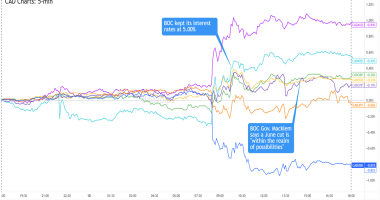Fed Chair Powell’s speech from Jackson Hole was the main event and determined the tone for the week, which was a net risk-off lean that benefited the U.S. dollar and Japanese yen.
But the top spot goes to the Aussie dollar, likely finding bids after arguably better-than-expected sentiment data from Australia on Tuesday.
Notable News & Economic Updates:
PBOC trimmed its five-year loan prime rate on Monday to 4.30% from 4.45% and its one year- loan prime rate to 3.65% from 3.70% on Monday
China plans $29 billion in special loans to troubled developers
Indonesia central bank surprised with a 25bps interest rate hike to 3.75%, the first hike since 2018
Oil inventories fall by more than expected 5.6M barrels last week: API
Central Bank of Iceland raised the key seven-day term deposit rate by 75 bps to 5.50%
U.S. crude and fuel inventories fell last week by 3.3M bbl vs. 933K bbl forecast, despite U.S. 8M bbl from SPR
Flash Eurozone Manufacturing PMI for August: 49.7 v.s 49.8 previous; Services index at 50.2 vs. 51.2 in July
Thursday, as expected, the South Korean central bank increased its main interest rate by a quarter-point to 2.50% in an effort to curb inflation
China’s foreign exchange regulator called a number of banks on Wednesday to caution them against selling Chinese currency excessively – Reuters
Federal Reserve Chair Powell warned of “some pain” in the future in his annual Jackson Hole policy speech on Friday; higher interest rates will persist for some time.
Intermarket Weekly Recap
We saw relatively limited price volatility for most of the week as traders likely hung out on the sidelines, waiting to see what they’ll get from the highly anticipated Jackson Hole Economic Policy Symposium. Given that the main event, Fed Chair Powell’s speech, was on Friday, we’ll do a quick recap on Jackson Hole a bit later.
Leading up to Jackson Hole, the economic calendar gave us a pretty steady stream of global economic updates and sentiment survey data. On net, it looks to like we saw a negative lean to the global economy, highlighted by another round of weak PMI survey data from Europe and U.S., and actions taken by China on Monday to support the economy
The data also showed further weakening in the housing markets, likely a continued reaction to the ever rising mortgage rates. And this week’s inflation rate data came in mixed, somewhat supporting the “peak” inflation narrative that’s starting to grow. But traders also understand that prices remain at relatively high levels despite slowing inflation rates, and would likely mean interest rates will remain high for some time.
And that’s exactly the rhetoric that we got from the Jackson Hole Economic Policy Symposium, where the world’s elite financial and central bank figures meet annually to discuss global monetary policy. Several Federal Reserve members spoke on the need to stay vigilant on inflation, capped off on Friday with comments from the man himself, Fed Chair Jerome Powell, that interest rates will likely stay high and that some economic pain may be ahead.
These comments were the catalyst for the sharp market moves during the Friday U.S. trading session, where risk assets took a dip and the U.S. dollar bounced. Traders likely priced in a higher probability of higher interest rates ahead and what that may mean for the future economic outlook and demand for risk assets.
In the forex space, the Aussie dollar took the top spot, possibly on net positive reads in business and consumer sentiment surveys; a bit of an outlier relative to what we’re seeing in other parts of the world.
The Aussie was closely followed in performance by the U.S. dollar and Japanese yen, which is not unusual given that the driving theme seems to be the negative sentiment on the global economy and higher rates ahead.
The biggest loser was the New Zealand dollar, which is likely a reaction to broad risk-off flows and comments from Reserve Bank of New Zealand Governor Orr that the aggressive tightening cycle may be nearing its end. The euro was also a big loser this week as the continued surge higher in gas prices are likely driving sentiment that economic pain will continue, and possibly worsen, ahead for Europe.
USD Pairs
S&P Flash U.S. Manufacturing PMI at 51.3 in August vs. 52.2 in June; Services Index fell to 44.1 vs. 47.3 previous
U.S. new home sales plunge in July by -12.6% to 511K; June sales was revised lower to 585K from 590K; Pending home sales fell -19.9% y/y in July; -1.0% m/m; U.S. mortgage applications fell last week by -1% w/w; -21% y/y
Fed official Kashkari: Biggest fear is that inflation will be more persistent
U.S. Durable Goods Orders for July: 0.0% m/m vs. 2.0% m/m previous; core durable goods orders was +0.3% vs. +0.4%
Federal Reserve Bank of Atlanta President Raphael Bostic said on Thursday that he’s split between a 50 bps and 75 bps hike in September – WSJ
Kansas City Fed President Esther George says the Fed has to get rates higher (possibly over 4% for a time) to slow down demand
U.S. jobless claims fell by 2K to 243k last week; continuing claims fell to 1.42M
Federal Reserve Bank of St. Louis President James Bullard said on Friday that the Fed cannot only rely on the market to get interest rates up
In July, the personal consumption expenditures price index recorded a 6.3% y/y increase, down from 6.8% y/y in June.
U.S. Personal income, spending edge were slightly higher in July at +0.2% m/m and +0.1% m/m respectively, below expectations and previous reads
GBP Pairs
U.K. Flash Manufacturing PMI at 46.0 in July vs. 52.1 previous; Services PMI ticked lower to 52.5 vs. 52.6
U.K. retail sales growth rate was +37% m/m in August vs. -4% in July. Next month, retailers anticipate another rapid increase in sales of around+31%
British household energy bills to jump 80% to over 3,549 pounds a year by October; prices could be as high as 6,616 pounds in Q2 2023 – Cornwall Insight
EUR Pairs
Germany Bundesbank Monthly Report: German recession increasingly likely
Germany’s PMIs still contractionary, services PMI deepens contraction from 49.7 to 48.2
Flash Consumer Confidence in the Euro Area rose +2.1 to -24.9; +1.0 to -26.0 in the EU
German IfO business climate index eases to 88.5 in August vs. 86.8 expected
Germany Q2 final GDP +0.1% q/q vs 0.0% q/q preliminary reads
European Central Bank July 20-21 2022 meeting account: at upcoming meetings, further normalization of rates would be appropriate. future poicy rate path will continue to be data-dependent
German GfK consumer climate index slumped from -30.9 to -36.5 vs. -32.1 estimate
In July 2022, the annual growth rate of broad monetary aggregate M3 declined to 5.5% from 5.7% in June.
CHF Pairs

Overlay of CHF Pairs: 1-Hour Forex Chart
CAD Pairs
Canada’s new-home prices rose 0.1% from the previous month in July, the smallest annual increase since June 2020
Employers in Canada continue to report record levels of job vacancies, with unfilled positions increasing by 32.5K in June to 1.03M.
Canada flash manufacturing sales in July: -0.9% m/m
Canada Average weekly earnings increased 3.5% y/y in June vs. +2.5% y/y in May
NZD Pairs

Overlay of NZD Pairs: 1-Hour Forex Chart
Reserve Bank of New Zealand Deputy Governor Christian Hawkesby: Cash rate can reach 4.25% before RBNZ has a more balanced view
New Zealand retail sales drop by -2.3% in Q2, raising technical recession risks
RBNZ Chief Adrian Orr signaled on Friday that an aggressive tightening cycle is nearing its end
AUD Pairs
Flash Australia Manufacturing PMI dips to 54.4 in August vs. 55.7 in July; Services PMI goes contractionary at 49.6 vs. 50.9 previous
Australia Weekly Consumer Confidence Index bounced to 84.2 vs. 80.3 previous
JPY Pairs
Japan Flash Manufacturing Output Index is lower once again to 48.3 in August vs. 49.7 in July; Services Index fell to 49.2 vs. 50.3
Bank of Japan Core CPI: +1.8% y/y in July vs. +1.6.% previous
Japan Prime Minister Kishida sets the stage for a shift on nuclear energy
BOJ official Toyoaki Nakamura pledged to maintain ultra-low rates and dovish policy guidance
Japan Services PPI for July: +2.1% y/y to 107.3 vs. a revised 2.1% y/y rate in June
Tokyo core CPI rose from 2.3% to 2.6% vs. 2.5% forecast
















